|
SNAP Library 6.0, Developer Reference
2020-12-09 16:24:20
SNAP, a general purpose, high performance system for analysis and manipulation of large networks
|
|
SNAP Library 6.0, Developer Reference
2020-12-09 16:24:20
SNAP, a general purpose, high performance system for analysis and manipulation of large networks
|
#include <cascdynetinf.h>
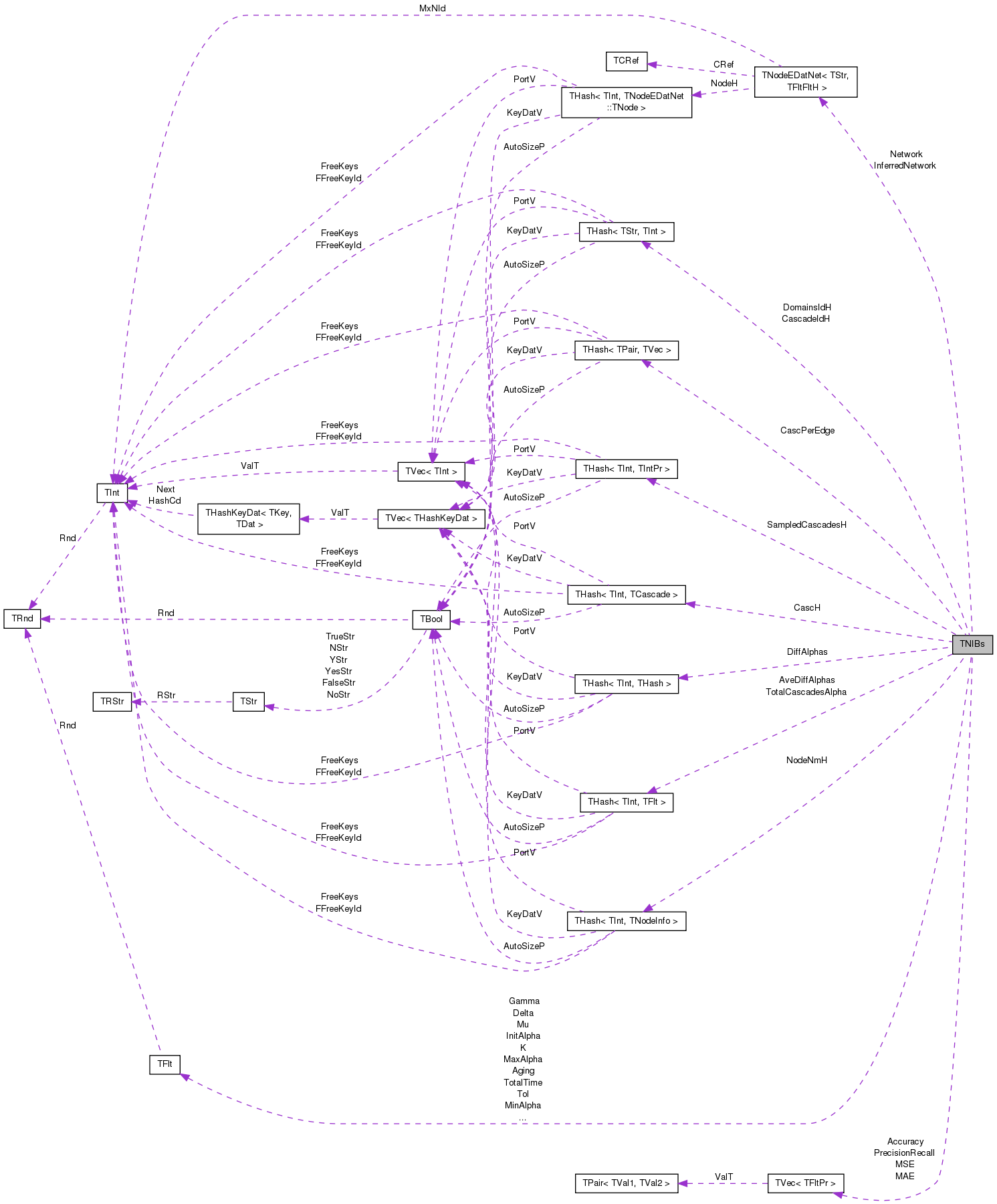
Public Member Functions | |
| TNIBs () | |
| TNIBs (TSIn &SIn) | |
| void | Save (TSOut &SOut) const |
| void | LoadCascadesTxt (TSIn &SIn) |
| void | LoadGroundTruthTxt (TSIn &SIn) |
| void | LoadGroundTruthNodesTxt (TSIn &SIn) |
| void | LoadInferredTxt (TSIn &SIn) |
| void | LoadInferredNodesTxt (TSIn &SIn) |
| void | SetTotalTime (const float &tt) |
| void | SetModel (const TModel &model) |
| void | SetWindow (const double &window) |
| void | SetDelta (const double &delta) |
| void | SetK (const double &k) |
| void | SetGamma (const double &gamma) |
| void | SetAging (const double &aging) |
| void | SetRegularizer (const TRegularizer ®) |
| void | SetMu (const double &mu) |
| void | SetTolerance (const double &tol) |
| void | SetMaxAlpha (const double &ma) |
| void | SetMinAlpha (const double &ma) |
| void | SetInitAlpha (const double &ia) |
| void | AddCasc (const TStr &CascStr, const TModel &Model=EXP) |
| void | AddCasc (const TCascade &Cascade) |
| void | AddCasc (const TIntFltH &Cascade, const int &CId=-1, const TModel &Model=EXP) |
| void | GenCascade (TCascade &C) |
| bool | IsCascade (int c) |
| TCascade & | GetCasc (int c) |
| int | GetCascs () |
| int | GetCascadeId (const TStr &Cascade) |
| int | GetNodes () |
| void | AddNodeNm (const int &NId, const TNodeInfo &Info) |
| TStr | GetNodeNm (const int &NId) const |
| TNodeInfo | GetNodeInfo (const int &NId) const |
| bool | IsNodeNm (const int &NId) const |
| void | SortNodeNmByVol (const bool &asc=false) |
| void | AddDomainNm (const TStr &Domain, const int &DomainId=-1) |
| bool | IsDomainNm (const TStr &Domain) const |
| int | GetDomainId (const TStr &Domain) |
| void | GetGroundTruthGraphAtT (const double &Step, PNGraph &GraphAtT) |
| void | GetGroundTruthNetworkAtT (const double &Step, PStrFltNEDNet &NetworkAtT) |
| void | GetInferredGraphAtT (const double &Step, PNGraph &GraphAtT) |
| void | GetInferredNetworkAtT (const double &Step, PStrFltNEDNet &NetworkAtT) |
| void | Reset () |
| void | Init (const TFltV &Steps) |
| void | SG (const int &NId, const int &Iters, const TFltV &Steps, const TSampling &Sampling, const TStr &ParamSampling=TStr(""), const bool &PlotPerformance=false) |
| void | BSG (const int &NId, const int &Iters, const TFltV &Steps, const int &BatchLen, const TSampling &Sampling, const TStr &ParamSampling=TStr(""), const bool &PlotPerformance=false) |
| void | FG (const int &NId, const int &Iters, const TFltV &Steps) |
| void | UpdateDiff (const TOptMethod &OptMethod, const int &NId, TCascade &Cascade, TIntPrV &AlphasToUpdate, const double &CurrentTime=TFlt::Mx) |
| void | find_C (int t, TFltV &x, TFltVV &C, const int &k, const double &s, const double &gamma, const double &T) |
| void | find_min_state (TFltVV &C, TIntV &states, const int &k, const double &s, const double &gamma, const double &T) |
| void | LabelBurstAutomaton (const int &SrcId, const int &DstId, TIntV &state_labels, TFltV &state_times, const bool &inferred=false, const int &k=5, const double &s=2.0, const double &gamma=1.0, const TSecTm &MinTime=TSecTm(), const TSecTm &MaxTime=TSecTm()) |
| void | ComputePerformanceNId (const int &NId, const int &Step, const TFltV &Steps) |
| void | SaveInferredPajek (const TStr &OutFNm, const double &Step, const TIntV &NIdV=TIntV()) |
| void | SaveInferred (const TStr &OutFNm, const TIntV &NIdV=TIntV()) |
| void | SaveInferred (const TStr &OutFNm, const double &Step, const TIntV &NIdV=TIntV()) |
| void | SaveInferredEdges (const TStr &OutFNm) |
| void | SaveGroundTruthPajek (const TStr &OutFNm, const double &Step) |
| void | SaveGroundTruth (const TStr &OutFNm) |
| void | SaveSites (const TStr &OutFNm, const TIntFltVH &CascadesPerNode=TIntFltVH()) |
| void | SaveCascades (const TStr &OutFNm) |
Definition at line 130 of file cascdynetinf.h.
|
inline |
Definition at line 173 of file cascdynetinf.h.
|
inline |
Definition at line 147 of file cascdynetinf.cpp.
References TCascade::Add(), CascH, GetNodeInfo(), THash< TKey, TDat, THashFunc >::Len(), TVec< TVal, TSizeTy >::Len(), TCascade::Sort(), TStr::SplitOnAllCh(), and TNodeInfo::Vol.
Referenced by AddCasc(), and LoadCascadesTxt().
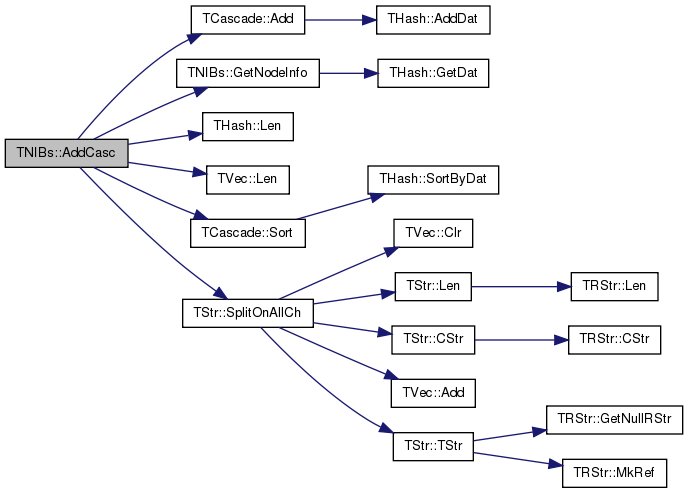

|
inline |
Definition at line 205 of file cascdynetinf.h.
References THash< TKey, TDat, THashFunc >::AddDat(), and TCascade::CId.

Definition at line 170 of file cascdynetinf.cpp.
References TCascade::Add(), AddCasc(), THash< TKey, TDat, THashFunc >::BegI(), THash< TKey, TDat, THashFunc >::EndI(), GetNodeInfo(), and TCascade::Sort().
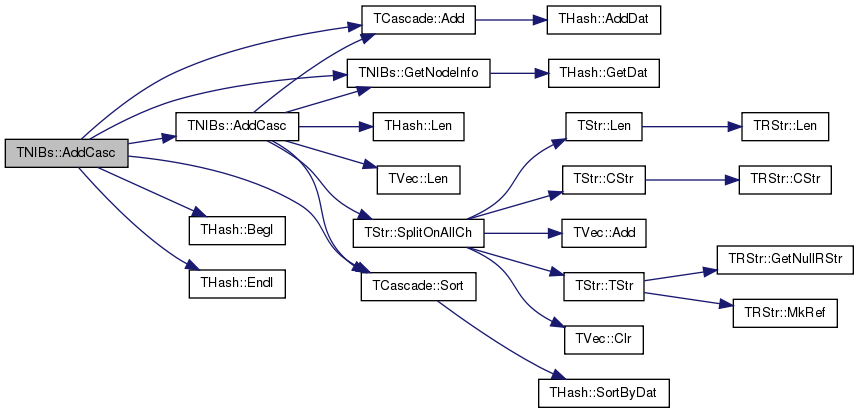
|
inline |
Definition at line 222 of file cascdynetinf.h.
References THash< TKey, TDat, THashFunc >::AddDat(), and THash< TKey, TDat, THashFunc >::Len().

|
inline |
Definition at line 215 of file cascdynetinf.h.
References THash< TKey, TDat, THashFunc >::AddDat().
Referenced by LoadCascadesTxt(), LoadGroundTruthNodesTxt(), LoadGroundTruthTxt(), LoadInferredNodesTxt(), and LoadInferredTxt().

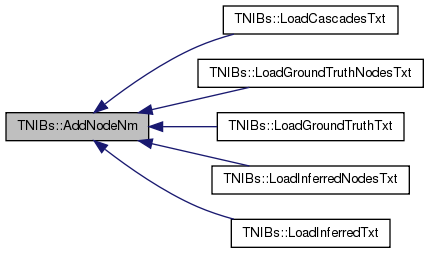
| void TNIBs::BSG | ( | const int & | NId, |
| const int & | Iters, | ||
| const TFltV & | Steps, | ||
| const int & | BatchLen, | ||
| const TSampling & | Sampling, | ||
| const TStr & | ParamSampling = TStr(""), |
||
| const bool & | PlotPerformance = false |
||
| ) |
Definition at line 501 of file cascdynetinf.cpp.
References THash< TKey, TDat, THashFunc >::AddDat(), AveDiffAlphas, TNodeEDatNet< TNodeData, TEdgeData >::BegEI(), CascH, THash< TKey, TDat, THashFunc >::Clr(), ComputePerformanceNId(), TNodeEDatNet< TNodeData, TEdgeData >::EndEI(), EXP_SAMPLING, Gamma, THash< TKey, TDat, THashFunc >::GetDat(), TNodeEDatNet< TNodeData, TEdgeData >::GetEDat(), THash< TKey, TDat, THashFunc >::GetKey(), TNodeEDatNet< TNodeData, TEdgeData >::GetNodes(), TRnd::GetUniDevInt(), InferredNetwork, TNodeEDatNet< TNodeData, TEdgeData >::IsEdge(), THash< TKey, TDat, THashFunc >::IsKey(), THash< TKey, TDat, THashFunc >::Len(), TVec< TVal, TSizeTy >::Len(), MaxAlpha, Mu, OBSG, RAY_SAMPLING, Regularizer, Reset(), TInt::Rnd, TFlt::Rnd, THash< TKey, TDat, THashFunc >::SortByDat(), TStr::SplitOnAllCh(), Tol, UNIF_SAMPLING, UpdateDiff(), WIN_EXP_SAMPLING, and WIN_SAMPLING.
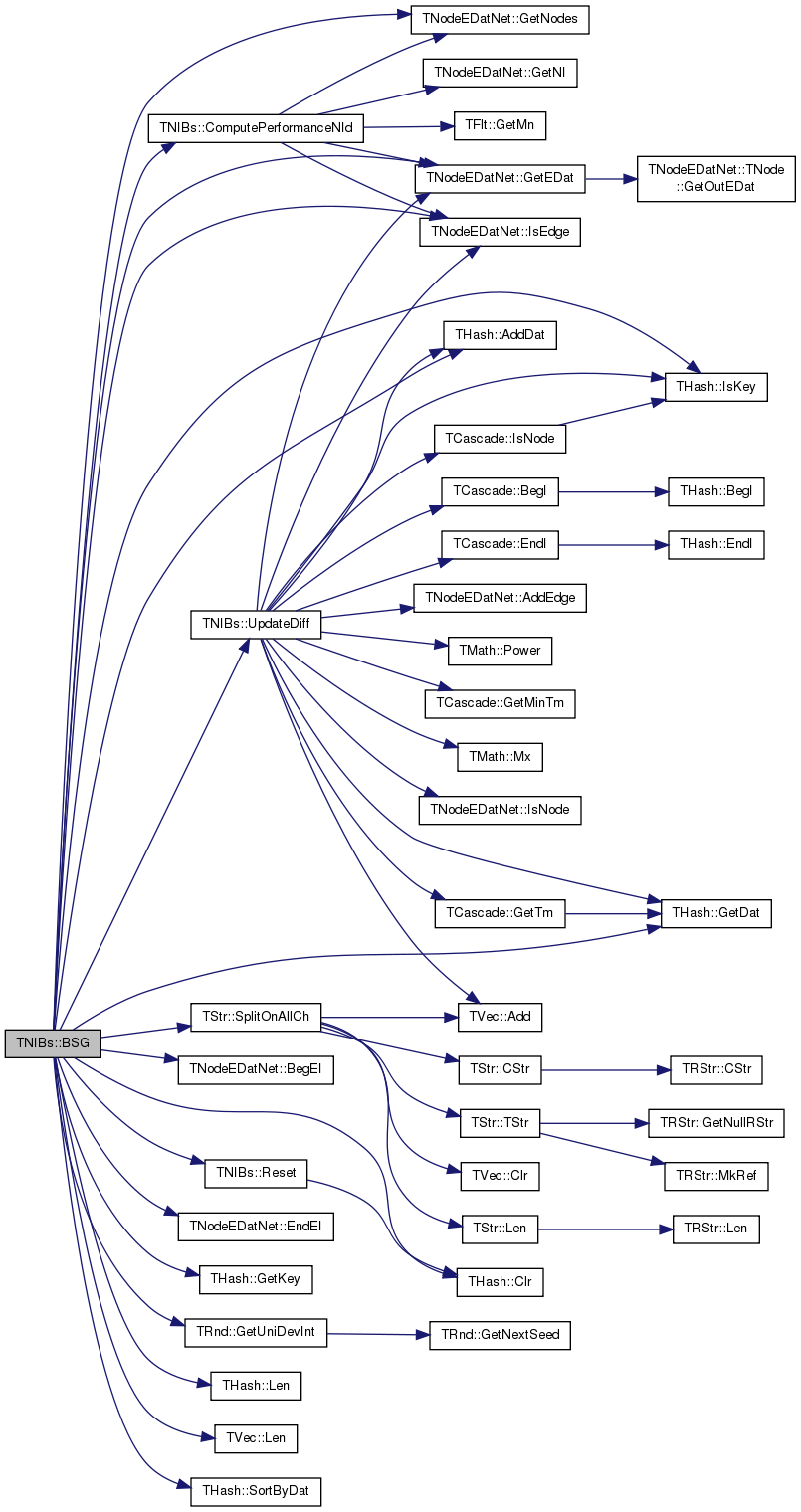
| void TNIBs::ComputePerformanceNId | ( | const int & | NId, |
| const int & | Step, | ||
| const TFltV & | Steps | ||
| ) |
Definition at line 918 of file cascdynetinf.cpp.
References Accuracy, TNodeEDatNet< TNodeData, TEdgeData >::GetEDat(), TFlt::GetMn(), TNodeEDatNet< TNodeData, TEdgeData >::GetNI(), TNodeEDatNet< TNodeData, TEdgeData >::GetNodes(), InferredNetwork, TNodeEDatNet< TNodeData, TEdgeData >::IsEdge(), MAE, MaxAlpha, MinAlpha, MSE, Network, PrecisionRecall, TPair< TVal1, TVal2 >::Val1, and TPair< TVal1, TVal2 >::Val2.
Referenced by BSG(), FG(), and SG().


| void TNIBs::FG | ( | const int & | NId, |
| const int & | Iters, | ||
| const TFltV & | Steps | ||
| ) |
Definition at line 631 of file cascdynetinf.cpp.
References THash< TKey, TDat, THashFunc >::AddDat(), AveDiffAlphas, TNodeEDatNet< TNodeData, TEdgeData >::BegEI(), CascH, THash< TKey, TDat, THashFunc >::Clr(), ComputePerformanceNId(), TNodeEDatNet< TNodeData, TEdgeData >::EndEI(), Gamma, THash< TKey, TDat, THashFunc >::GetDat(), TNodeEDatNet< TNodeData, TEdgeData >::GetEDat(), THash< TKey, TDat, THashFunc >::GetKey(), TNodeEDatNet< TNodeData, TEdgeData >::GetNodes(), InferredNetwork, TNodeEDatNet< TNodeData, TEdgeData >::IsEdge(), THash< TKey, TDat, THashFunc >::Len(), TVec< TVal, TSizeTy >::Len(), MaxAlpha, Mu, OBSG, Regularizer, Reset(), THash< TKey, TDat, THashFunc >::SortByDat(), Tol, and UpdateDiff().
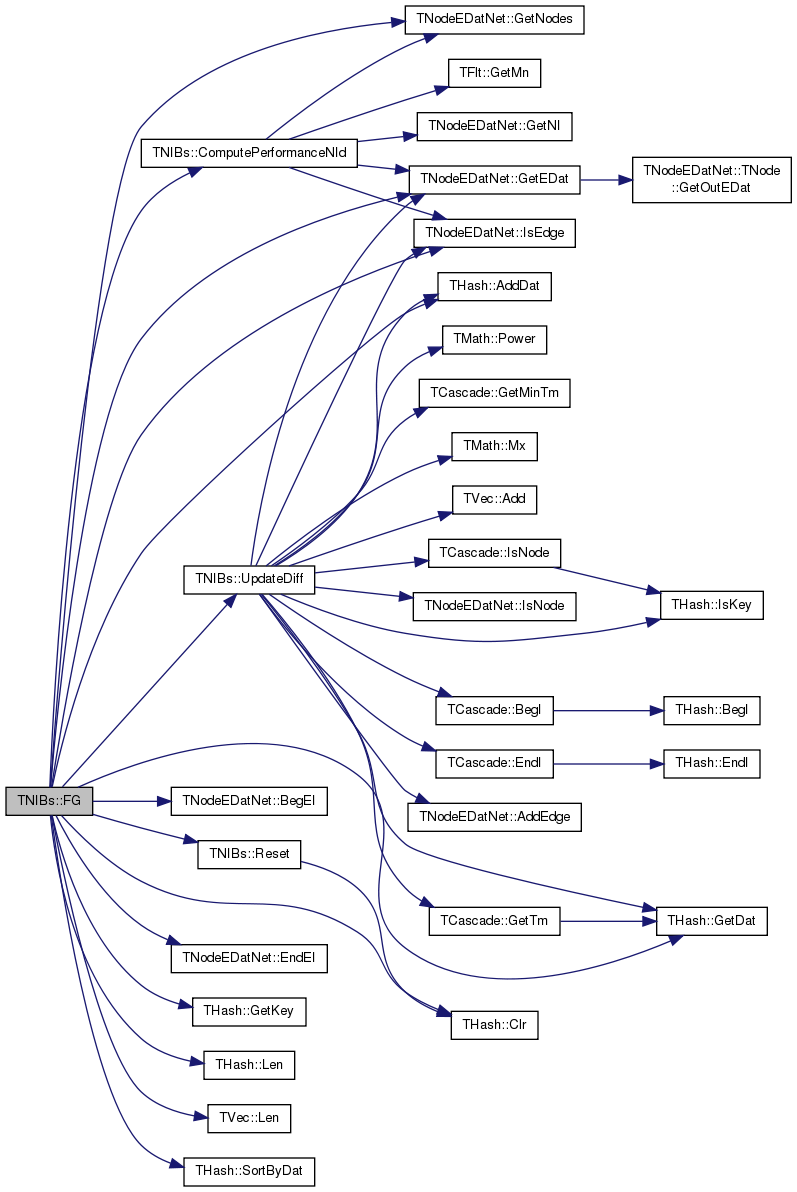
| void TNIBs::find_C | ( | int | t, |
| TFltV & | x, | ||
| TFltVV & | C, | ||
| const int & | k, | ||
| const double & | s, | ||
| const double & | gamma, | ||
| const double & | T | ||
| ) |
Definition at line 835 of file cascdynetinf.cpp.
References TVec< TVal, TSizeTy >::Len().
Referenced by LabelBurstAutomaton().


| void TNIBs::find_min_state | ( | TFltVV & | C, |
| TIntV & | states, | ||
| const int & | k, | ||
| const double & | s, | ||
| const double & | gamma, | ||
| const double & | T | ||
| ) |
Definition at line 865 of file cascdynetinf.cpp.
References TVVec< TVal, TSizeTy >::GetCols(), and TVVec< TVal, TSizeTy >::GetRows().
Referenced by LabelBurstAutomaton().


| void TNIBs::GenCascade | ( | TCascade & | C | ) |
Definition at line 180 of file cascdynetinf.cpp.
References TCascade::Add(), THash< TKey, TDat, THashFunc >::AddDat(), THash< TKey, TDat, THashFunc >::BegI(), TCascade::Clr(), THash< TKey, TDat, THashFunc >::Clr(), Delta, EXP, THashKeyDatI< TKey, TDat >::GetDat(), THash< TKey, TDat, THashFunc >::GetDat(), TNodeEDatNet< TNodeData, TEdgeData >::GetEDat(), TRnd::GetExpDev(), THashKeyDatI< TKey, TDat >::GetKey(), THash< TKey, TDat, THashFunc >::GetKey(), TFlt::GetMn(), TNodeEDatNet< TNodeData, TEdgeData >::GetNI(), TNodeEDatNet< TNodeData, TEdgeData >::GetNodes(), TRnd::GetPowerDev(), TRnd::GetRayleigh(), TNodeEDatNet< TNodeData, TEdgeData >::GetRndNId(), TRnd::GetUniDev(), IAssert, THash< TKey, TDat, THashFunc >::IsKey(), TCascade::Len(), THash< TKey, TDat, THashFunc >::Len(), Model, Network, POW, TRnd::Randomize(), RAY, TInt::Rnd, TFlt::Rnd, TCascade::Sort(), THash< TKey, TDat, THashFunc >::SortByDat(), TotalTime, TInt::Val, and Window.
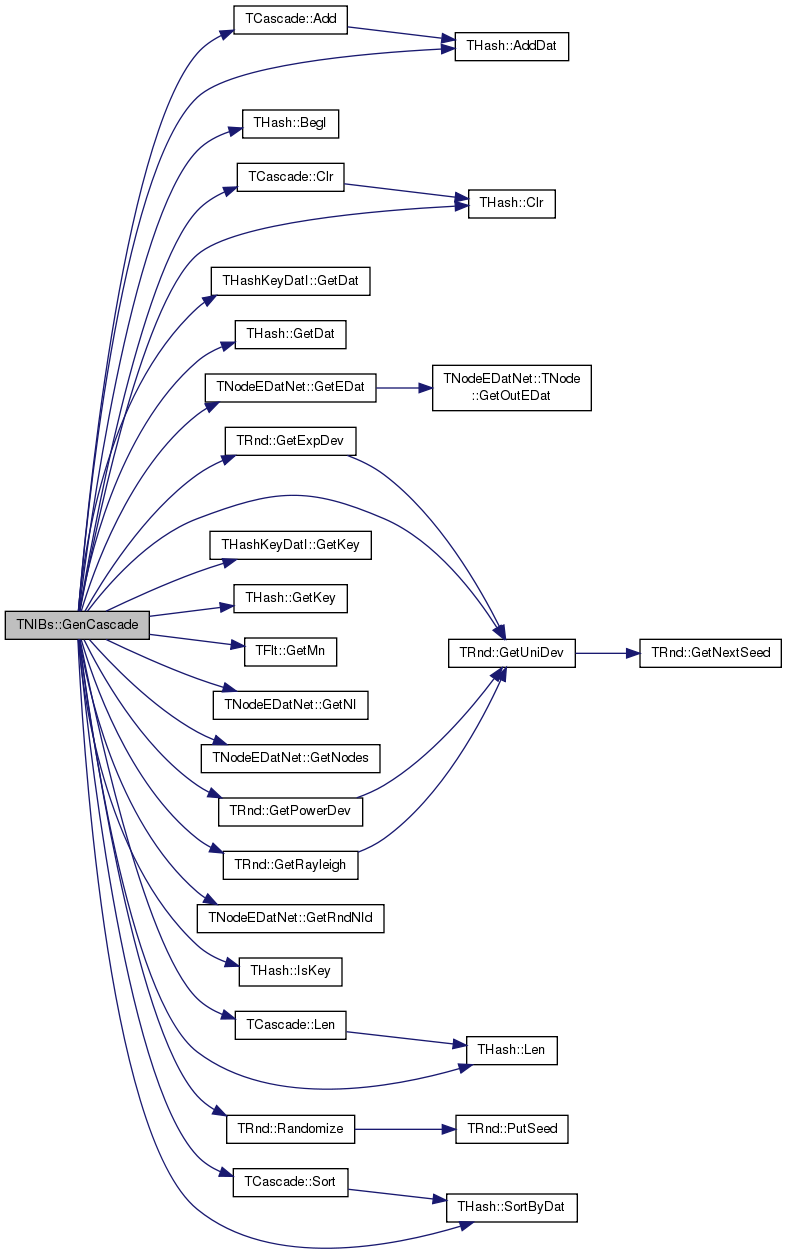
|
inline |
Definition at line 209 of file cascdynetinf.h.
References THash< TKey, TDat, THashFunc >::GetDat().

|
inline |
Definition at line 211 of file cascdynetinf.h.
References THash< TKey, TDat, THashFunc >::GetDat().

|
inline |
Definition at line 210 of file cascdynetinf.h.
References THash< TKey, TDat, THashFunc >::Len().

|
inline |
Definition at line 224 of file cascdynetinf.h.
References THash< TKey, TDat, THashFunc >::GetDat().

| void TNIBs::GetGroundTruthGraphAtT | ( | const double & | Step, |
| PNGraph & | GraphAtT | ||
| ) |
Definition at line 279 of file cascdynetinf.cpp.
References TNGraph::AddEdge(), TNGraph::AddNode(), TNodeEDatNet< TNodeData, TEdgeData >::BegEI(), THash< TKey, TDat, THashFunc >::BegI(), TNodeEDatNet< TNodeData, TEdgeData >::EndEI(), THash< TKey, TDat, THashFunc >::EndI(), THash< TKey, TDat, THashFunc >::IsKey(), MinAlpha, Network, TNGraph::New(), and NodeNmH.
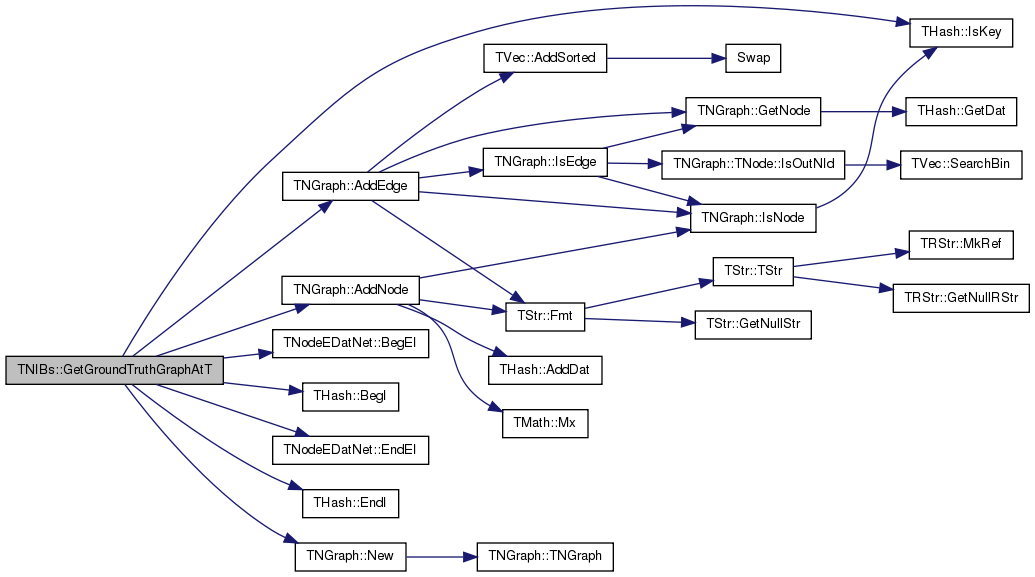
| void TNIBs::GetGroundTruthNetworkAtT | ( | const double & | Step, |
| PStrFltNEDNet & | NetworkAtT | ||
| ) |
Definition at line 295 of file cascdynetinf.cpp.
References TNodeEDatNet< TNodeData, TEdgeData >::BegEI(), THash< TKey, TDat, THashFunc >::BegI(), TNodeEDatNet< TNodeData, TEdgeData >::EndEI(), THash< TKey, TDat, THashFunc >::EndI(), THash< TKey, TDat, THashFunc >::IsKey(), MinAlpha, Network, TNodeEDatNet< TNodeData, TEdgeData >::New(), and NodeNmH.
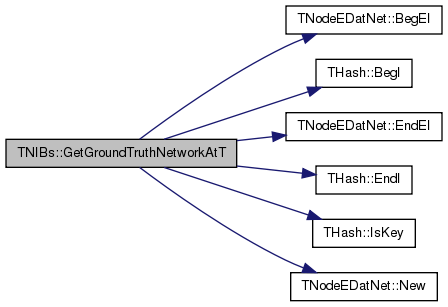
| void TNIBs::GetInferredGraphAtT | ( | const double & | Step, |
| PNGraph & | GraphAtT | ||
| ) |
Definition at line 311 of file cascdynetinf.cpp.
References TNGraph::AddEdge(), TNGraph::AddNode(), TNodeEDatNet< TNodeData, TEdgeData >::BegEI(), THash< TKey, TDat, THashFunc >::BegI(), TNodeEDatNet< TNodeData, TEdgeData >::EndEI(), THash< TKey, TDat, THashFunc >::EndI(), InferredNetwork, THash< TKey, TDat, THashFunc >::IsKey(), MinAlpha, TNGraph::New(), and NodeNmH.

| void TNIBs::GetInferredNetworkAtT | ( | const double & | Step, |
| PStrFltNEDNet & | NetworkAtT | ||
| ) |
Definition at line 328 of file cascdynetinf.cpp.
References TNodeEDatNet< TNodeData, TEdgeData >::BegEI(), THash< TKey, TDat, THashFunc >::BegI(), TNodeEDatNet< TNodeData, TEdgeData >::EndEI(), THash< TKey, TDat, THashFunc >::EndI(), InferredNetwork, THash< TKey, TDat, THashFunc >::IsKey(), MinAlpha, TNodeEDatNet< TNodeData, TEdgeData >::New(), and NodeNmH.
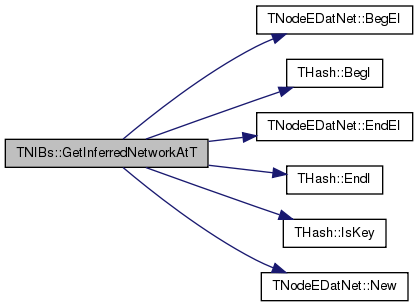
|
inline |
Definition at line 217 of file cascdynetinf.h.
References THash< TKey, TDat, THashFunc >::GetDat().
Referenced by AddCasc().


|
inline |
Definition at line 216 of file cascdynetinf.h.
References THash< TKey, TDat, THashFunc >::GetDat(), and TNodeInfo::Name.

|
inline |
Definition at line 214 of file cascdynetinf.h.
References TNodeEDatNet< TNodeData, TEdgeData >::GetNodes().

| void TNIBs::Init | ( | const TFltV & | Steps | ) |
Definition at line 347 of file cascdynetinf.cpp.
References Accuracy, TVec< TVal, TSizeTy >::Add(), TNodeEDatNet< TNodeData, TEdgeData >::AddNode(), THash< TKey, TDat, THashFunc >::BegI(), THash< TKey, TDat, THashFunc >::Clr(), TVec< TVal, TSizeTy >::Clr(), TNodeEDatNet< TNodeData, TEdgeData >::Clr(), THash< TKey, TDat, THashFunc >::EndI(), InferredNetwork, TVec< TVal, TSizeTy >::Len(), MAE, MSE, NodeNmH, PrecisionRecall, and TotalCascadesAlpha.

|
inline |
Definition at line 208 of file cascdynetinf.h.
References THash< TKey, TDat, THashFunc >::IsKey().

|
inline |
Definition at line 223 of file cascdynetinf.h.
References THash< TKey, TDat, THashFunc >::IsKey().

|
inline |
Definition at line 218 of file cascdynetinf.h.
References THash< TKey, TDat, THashFunc >::IsKey().
Referenced by LoadGroundTruthNodesTxt(), LoadGroundTruthTxt(), LoadInferredNodesTxt(), and LoadInferredTxt().

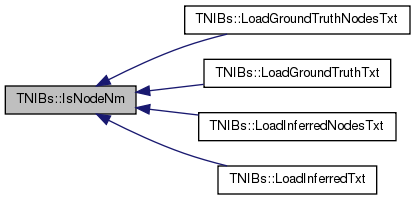
| void TNIBs::LabelBurstAutomaton | ( | const int & | SrcId, |
| const int & | DstId, | ||
| TIntV & | state_labels, | ||
| TFltV & | state_times, | ||
| const bool & | inferred = false, |
||
| const int & | k = 5, |
||
| const double & | s = 2.0, |
||
| const double & | gamma = 1.0, |
||
| const TSecTm & | MinTime = TSecTm(), |
||
| const TSecTm & | MaxTime = TSecTm() |
||
| ) |
Definition at line 886 of file cascdynetinf.cpp.
References TVec< TVal, TSizeTy >::Add(), find_C(), find_min_state(), TSecTm::GetAbsSecs(), TNodeEDatNet< TNodeData, TEdgeData >::GetEDat(), THash< TKey, TDat, THashFunc >::GetKey(), InferredNetwork, TVec< TVal, TSizeTy >::Last(), THash< TKey, TDat, THashFunc >::Len(), TVec< TVal, TSizeTy >::Len(), MinAlpha, Network, and TVec< TVal, TSizeTy >::Sort().
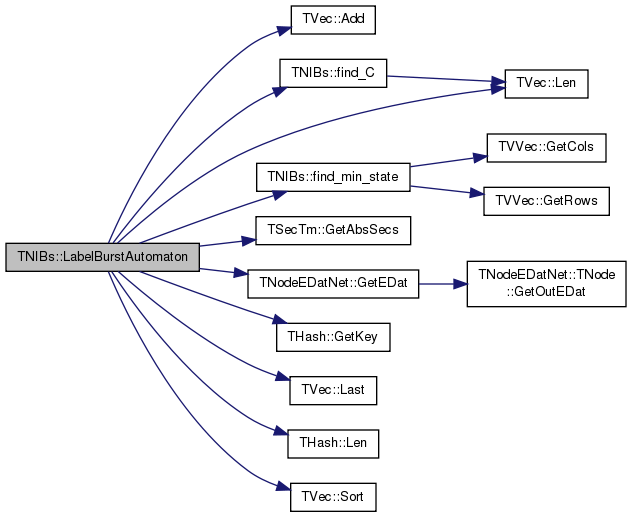
| void TNIBs::LoadCascadesTxt | ( | TSIn & | SIn | ) |
Definition at line 4 of file cascdynetinf.cpp.
References AddCasc(), AddNodeNm(), TSIn::Eof(), TSIn::GetNextLn(), Model, and TStr::SplitOnAllCh().
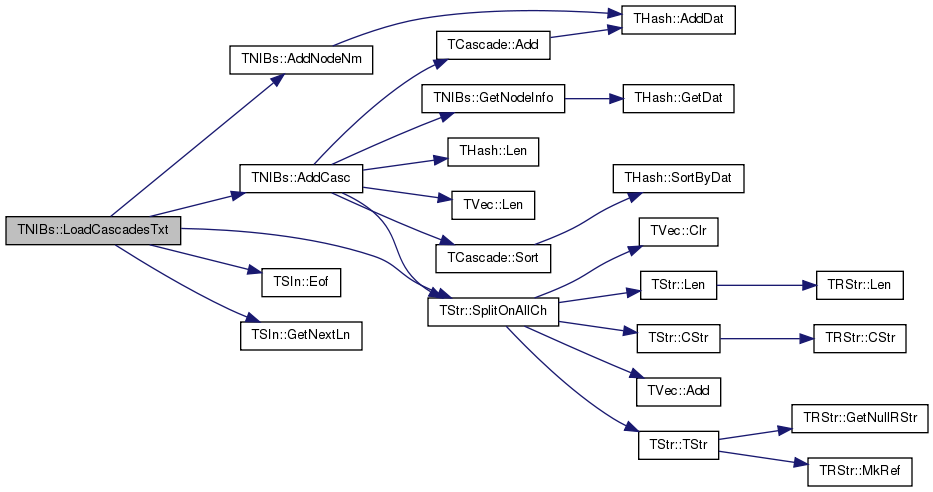
| void TNIBs::LoadGroundTruthNodesTxt | ( | TSIn & | SIn | ) |
Definition at line 63 of file cascdynetinf.cpp.
References THash< TKey, TDat, THashFunc >::AddDat(), TNodeEDatNet< TNodeData, TEdgeData >::AddNode(), AddNodeNm(), TNodeEDatNet< TNodeData, TEdgeData >::Clr(), DomainsIdH, TSIn::Eof(), TSIn::GetNextLn(), TNodeEDatNet< TNodeData, TEdgeData >::GetNodes(), IsNodeNm(), Network, and TStr::SplitOnAllCh().

| void TNIBs::LoadGroundTruthTxt | ( | TSIn & | SIn | ) |
Definition at line 18 of file cascdynetinf.cpp.
References THash< TKey, TDat, THashFunc >::AddDat(), TNodeEDatNet< TNodeData, TEdgeData >::AddEdge(), TNodeEDatNet< TNodeData, TEdgeData >::AddNode(), AddNodeNm(), TNodeEDatNet< TNodeData, TEdgeData >::Clr(), DomainsIdH, TSIn::Eof(), TNodeEDatNet< TNodeData, TEdgeData >::GetEDat(), TNodeEDatNet< TNodeData, TEdgeData >::GetEdges(), THash< TKey, TDat, THashFunc >::GetKey(), TSIn::GetNextLn(), TNodeEDatNet< TNodeData, TEdgeData >::GetNodes(), IsNodeNm(), THash< TKey, TDat, THashFunc >::Len(), TVec< TVal, TSizeTy >::Len(), Network, and TStr::SplitOnAllCh().

| void TNIBs::LoadInferredNodesTxt | ( | TSIn & | SIn | ) |
Definition at line 128 of file cascdynetinf.cpp.
References THash< TKey, TDat, THashFunc >::AddDat(), TNodeEDatNet< TNodeData, TEdgeData >::AddNode(), AddNodeNm(), TNodeEDatNet< TNodeData, TEdgeData >::Clr(), DomainsIdH, TSIn::Eof(), THash< TKey, TDat, THashFunc >::GetDat(), TSIn::GetNextLn(), TNodeEDatNet< TNodeData, TEdgeData >::GetNodes(), IAssert, InferredNetwork, THash< TKey, TDat, THashFunc >::IsKey(), IsNodeNm(), and TStr::SplitOnAllCh().
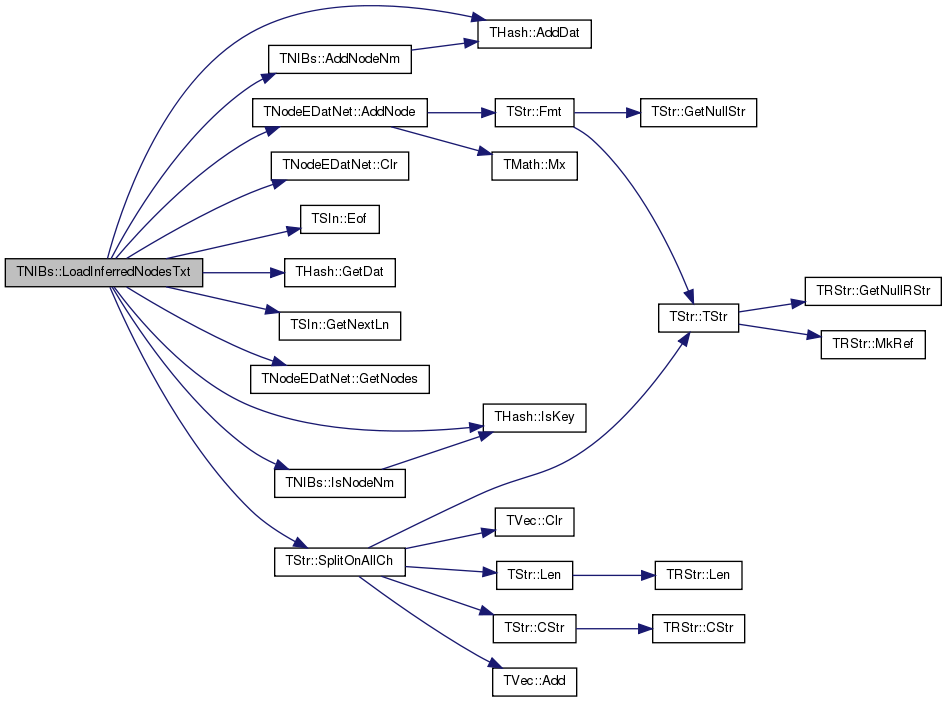
| void TNIBs::LoadInferredTxt | ( | TSIn & | SIn | ) |
Definition at line 83 of file cascdynetinf.cpp.
References THash< TKey, TDat, THashFunc >::AddDat(), TNodeEDatNet< TNodeData, TEdgeData >::AddEdge(), TNodeEDatNet< TNodeData, TEdgeData >::AddNode(), AddNodeNm(), TNodeEDatNet< TNodeData, TEdgeData >::Clr(), DomainsIdH, TSIn::Eof(), THash< TKey, TDat, THashFunc >::GetDat(), TNodeEDatNet< TNodeData, TEdgeData >::GetEDat(), TNodeEDatNet< TNodeData, TEdgeData >::GetEdges(), THash< TKey, TDat, THashFunc >::GetKey(), TSIn::GetNextLn(), TNodeEDatNet< TNodeData, TEdgeData >::GetNodes(), IAssert, InferredNetwork, THash< TKey, TDat, THashFunc >::IsKey(), IsNodeNm(), THash< TKey, TDat, THashFunc >::Len(), TVec< TVal, TSizeTy >::Len(), and TStr::SplitOnAllCh().
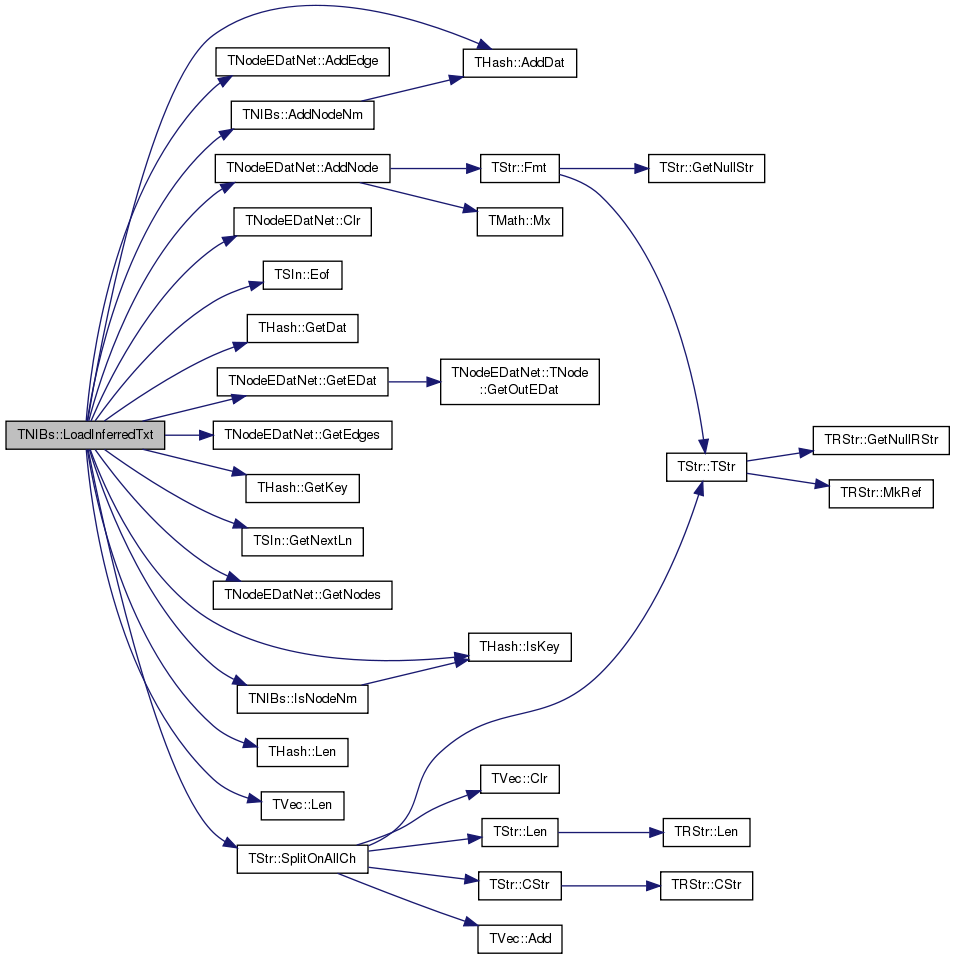
| void TNIBs::Reset | ( | ) |
Definition at line 370 of file cascdynetinf.cpp.
References AveDiffAlphas, THash< TKey, TDat, THashFunc >::Clr(), DiffAlphas, SampledCascadesH, and TotalCascadesAlpha.
Referenced by BSG(), FG(), and SG().

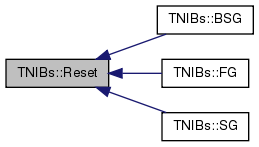
|
inline |
Definition at line 175 of file cascdynetinf.h.
References THash< TKey, TDat, THashFunc >::Save(), and TNodeEDatNet< TNodeData, TEdgeData >::Save().

| void TNIBs::SaveCascades | ( | const TStr & | OutFNm | ) |
Definition at line 1168 of file cascdynetinf.cpp.
References THash< TKey, TDat, THashFunc >::BegI(), CascH, THash< TKey, TDat, THashFunc >::EndI(), TStr::Fmt(), THash< TKey, TDat, THashFunc >::IsKey(), TCascade::NIdHitH, NodeNmH, and TSOut::PutStr().
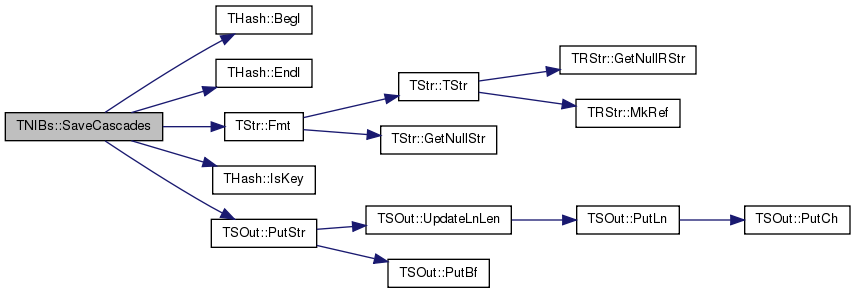
| void TNIBs::SaveGroundTruth | ( | const TStr & | OutFNm | ) |
Definition at line 1105 of file cascdynetinf.cpp.
References TNodeEDatNet< TNodeData, TEdgeData >::BegEI(), THash< TKey, TDat, THashFunc >::BegI(), TNodeEDatNet< TNodeData, TEdgeData >::EndEI(), THash< TKey, TDat, THashFunc >::EndI(), TStr::Fmt(), THash< TKey, TDat, THashFunc >::IsKey(), Network, NodeNmH, and TSOut::PutStr().
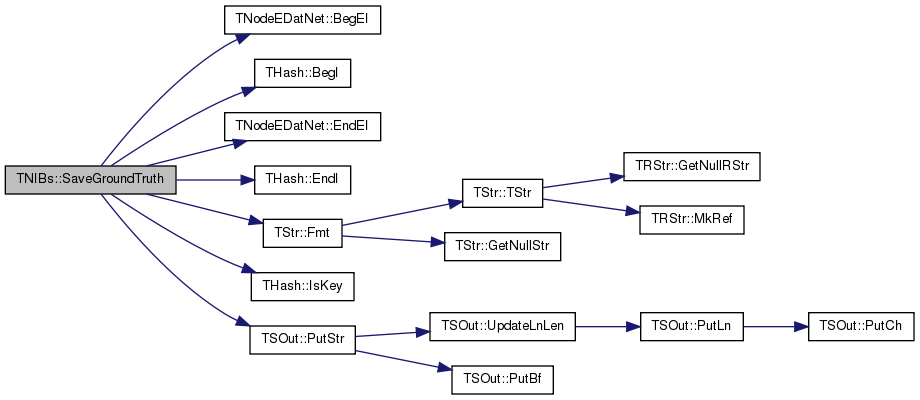
| void TNIBs::SaveGroundTruthPajek | ( | const TStr & | OutFNm, |
| const double & | Step | ||
| ) |
Definition at line 1133 of file cascdynetinf.cpp.
References TNodeEDatNet< TNodeData, TEdgeData >::BegEI(), THash< TKey, TDat, THashFunc >::BegI(), TNodeEDatNet< TNodeData, TEdgeData >::EndEI(), THash< TKey, TDat, THashFunc >::EndI(), TStr::Fmt(), THash< TKey, TDat, THashFunc >::IsKey(), THash< TKey, TDat, THashFunc >::Len(), MaxAlpha, MinAlpha, Network, NodeNmH, TSOut::PutStr(), and TFlt::Val.
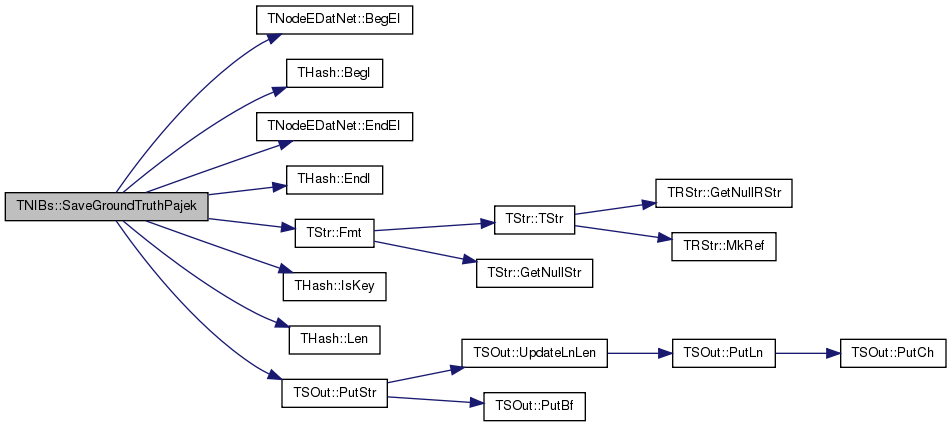
Definition at line 1003 of file cascdynetinf.cpp.
References TNodeEDatNet< TNodeData, TEdgeData >::BegEI(), THash< TKey, TDat, THashFunc >::BegI(), TNodeEDatNet< TNodeData, TEdgeData >::EndEI(), THash< TKey, TDat, THashFunc >::EndI(), TStr::Fmt(), InferredNetwork, TVec< TVal, TSizeTy >::IsIn(), THash< TKey, TDat, THashFunc >::IsKey(), TVec< TVal, TSizeTy >::Len(), MaxAlpha, MinAlpha, NodeNmH, TSOut::PutStr(), and TFlt::Val.
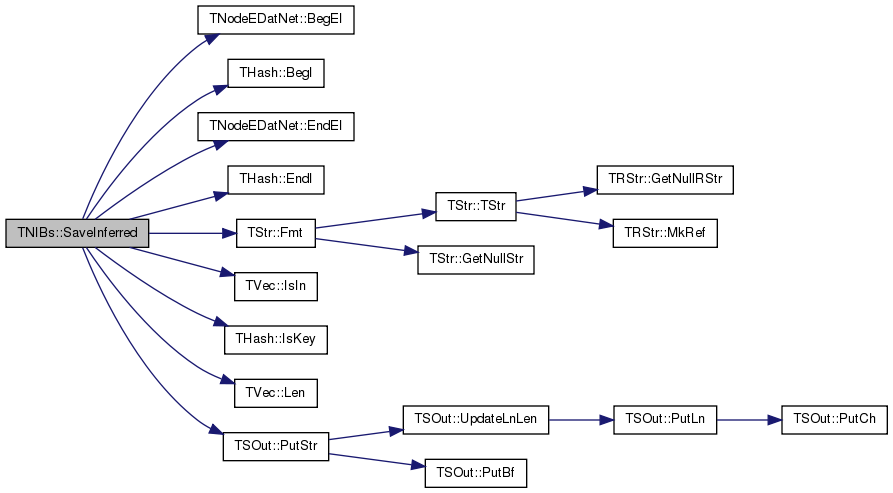
Definition at line 1045 of file cascdynetinf.cpp.
References TNodeEDatNet< TNodeData, TEdgeData >::BegEI(), THash< TKey, TDat, THashFunc >::BegI(), TNodeEDatNet< TNodeData, TEdgeData >::EndEI(), THash< TKey, TDat, THashFunc >::EndI(), TStr::Fmt(), InferredNetwork, TVec< TVal, TSizeTy >::IsIn(), THash< TKey, TDat, THashFunc >::IsKey(), TVec< TVal, TSizeTy >::Len(), MaxAlpha, MinAlpha, NodeNmH, TSOut::PutStr(), and TFlt::Val.
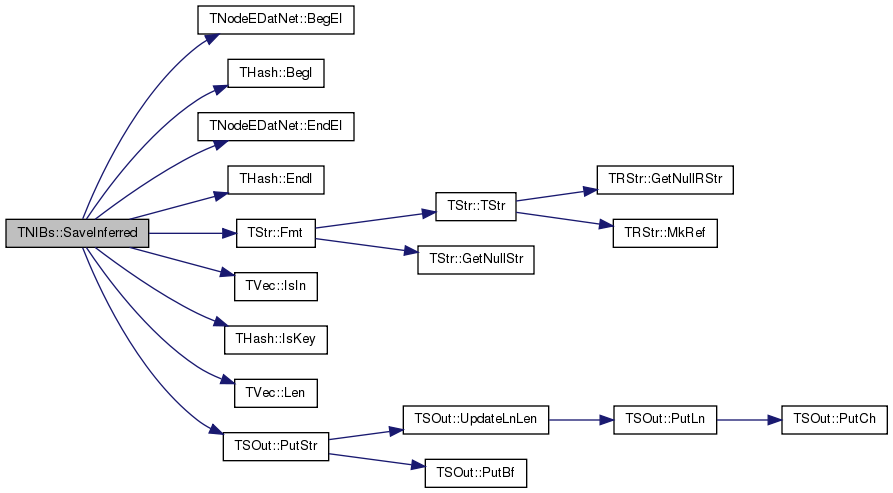
| void TNIBs::SaveInferredEdges | ( | const TStr & | OutFNm | ) |
Definition at line 1073 of file cascdynetinf.cpp.
References TNodeEDatNet< TNodeData, TEdgeData >::BegEI(), TNodeEDatNet< TNodeData, TEdgeData >::EndEI(), TStr::Fmt(), InferredNetwork, THash< TKey, TDat, THashFunc >::IsKey(), MaxAlpha, MinAlpha, NodeNmH, TSOut::PutStr(), and TFlt::Val.

| void TNIBs::SaveInferredPajek | ( | const TStr & | OutFNm, |
| const double & | Step, | ||
| const TIntV & | NIdV = TIntV() |
||
| ) |
Definition at line 981 of file cascdynetinf.cpp.
References TNodeEDatNet< TNodeData, TEdgeData >::BegEI(), THash< TKey, TDat, THashFunc >::BegI(), TNodeEDatNet< TNodeData, TEdgeData >::EndEI(), THash< TKey, TDat, THashFunc >::EndI(), TStr::Fmt(), InferredNetwork, TVec< TVal, TSizeTy >::IsIn(), THash< TKey, TDat, THashFunc >::IsKey(), THash< TKey, TDat, THashFunc >::Len(), TVec< TVal, TSizeTy >::Len(), MaxAlpha, MinAlpha, NodeNmH, TSOut::PutStr(), and TFlt::Val.
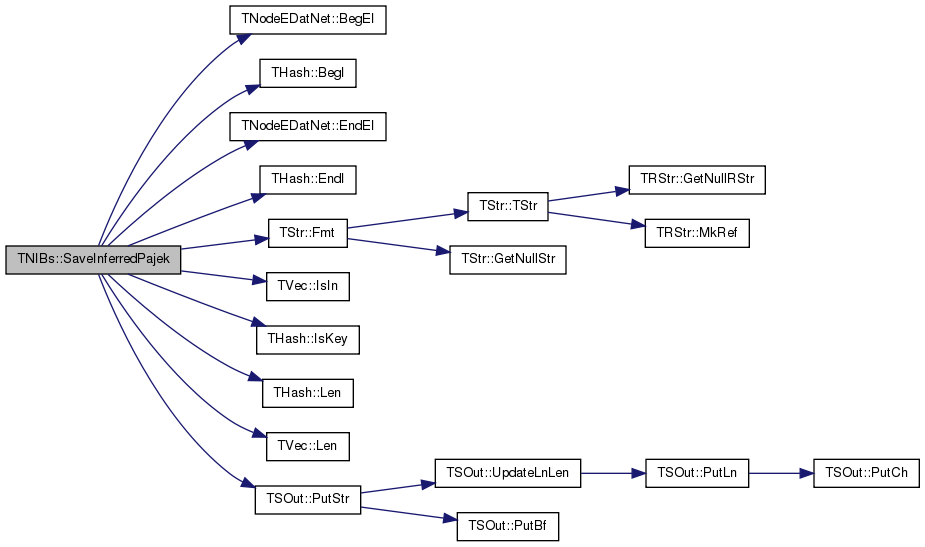
Definition at line 1153 of file cascdynetinf.cpp.
References THash< TKey, TDat, THashFunc >::BegI(), THash< TKey, TDat, THashFunc >::EndI(), TStr::Fmt(), THash< TKey, TDat, THashFunc >::GetDat(), THash< TKey, TDat, THashFunc >::IsKey(), NodeNmH, and TSOut::PutStr().
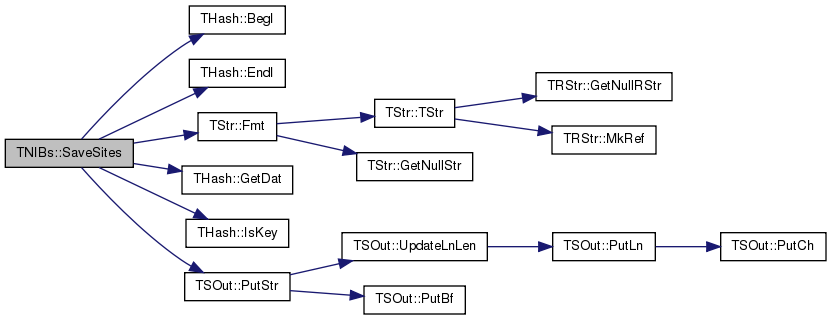
|
inline |
Definition at line 195 of file cascdynetinf.h.
|
inline |
Definition at line 190 of file cascdynetinf.h.
|
inline |
Definition at line 194 of file cascdynetinf.h.
|
inline |
Definition at line 201 of file cascdynetinf.h.
|
inline |
Definition at line 191 of file cascdynetinf.h.
|
inline |
Definition at line 199 of file cascdynetinf.h.
|
inline |
Definition at line 200 of file cascdynetinf.h.
|
inline |
Definition at line 186 of file cascdynetinf.h.
|
inline |
Definition at line 197 of file cascdynetinf.h.
|
inline |
Definition at line 196 of file cascdynetinf.h.
|
inline |
Definition at line 198 of file cascdynetinf.h.
|
inline |
Definition at line 185 of file cascdynetinf.h.
|
inline |
Definition at line 187 of file cascdynetinf.h.
| void TNIBs::SG | ( | const int & | NId, |
| const int & | Iters, | ||
| const TFltV & | Steps, | ||
| const TSampling & | Sampling, | ||
| const TStr & | ParamSampling = TStr(""), |
||
| const bool & | PlotPerformance = false |
||
| ) |
Definition at line 381 of file cascdynetinf.cpp.
References THash< TKey, TDat, THashFunc >::AddDat(), Aging, AveDiffAlphas, TNodeEDatNet< TNodeData, TEdgeData >::BegEI(), CascH, THash< TKey, TDat, THashFunc >::Clr(), ComputePerformanceNId(), TNodeEDatNet< TNodeData, TEdgeData >::EndEI(), EXP_SAMPLING, Gamma, THash< TKey, TDat, THashFunc >::GetDat(), TNodeEDatNet< TNodeData, TEdgeData >::GetEDat(), THash< TKey, TDat, THashFunc >::GetKey(), TRnd::GetUniDevInt(), InferredNetwork, TNodeEDatNet< TNodeData, TEdgeData >::IsEdge(), THash< TKey, TDat, THashFunc >::IsKey(), THash< TKey, TDat, THashFunc >::Len(), TVec< TVal, TSizeTy >::Len(), MaxAlpha, Mu, OSG, RAY_SAMPLING, Regularizer, Reset(), TInt::Rnd, TFlt::Rnd, THash< TKey, TDat, THashFunc >::SortByDat(), TStr::SplitOnAllCh(), Tol, UNIF_SAMPLING, UpdateDiff(), TFlt::Val, WIN_EXP_SAMPLING, and WIN_SAMPLING.
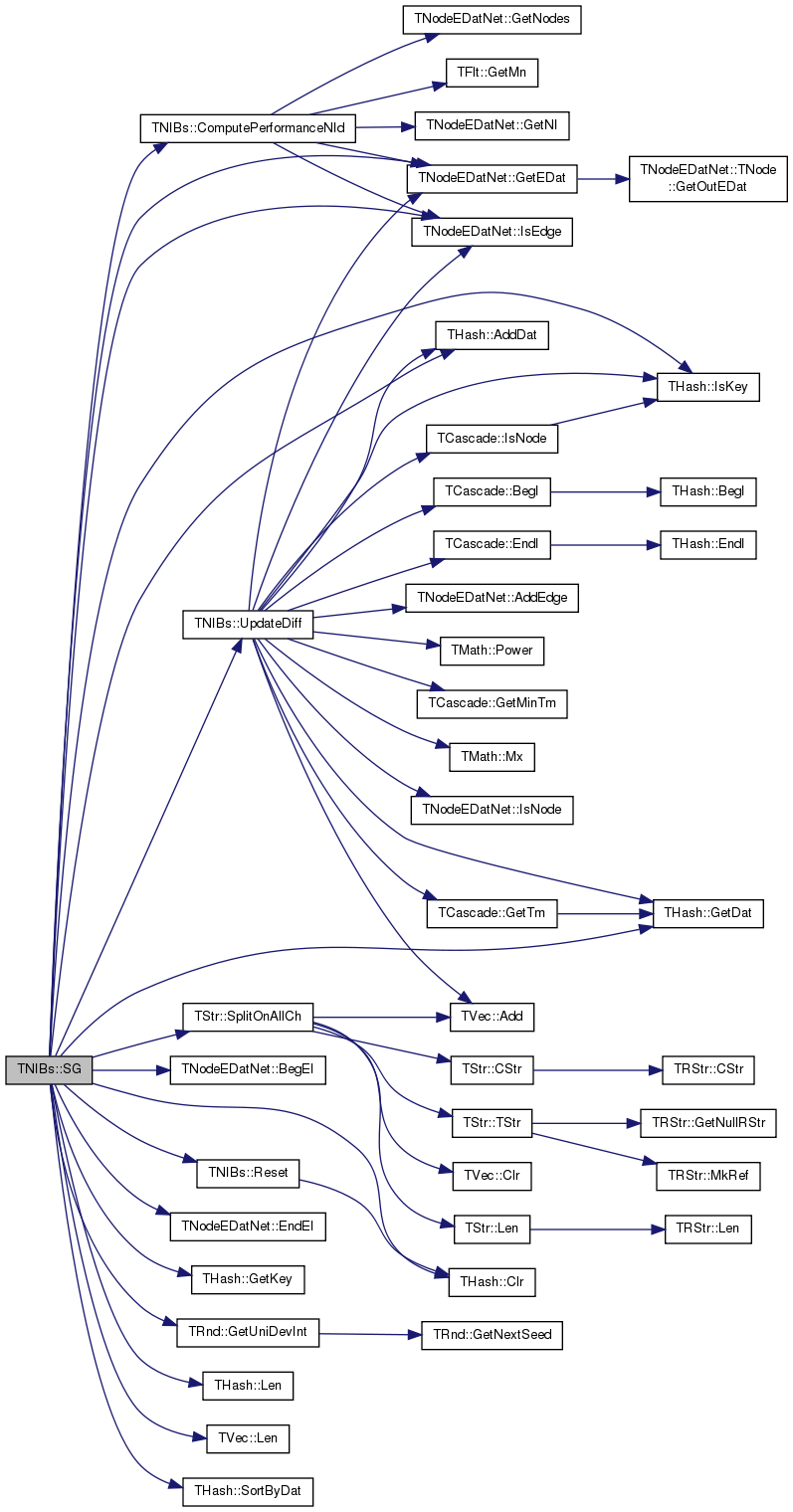
|
inline |
Definition at line 219 of file cascdynetinf.h.
References THash< TKey, TDat, THashFunc >::SortByDat().

| void TNIBs::UpdateDiff | ( | const TOptMethod & | OptMethod, |
| const int & | NId, | ||
| TCascade & | Cascade, | ||
| TIntPrV & | AlphasToUpdate, | ||
| const double & | CurrentTime = TFlt::Mx |
||
| ) |
Definition at line 721 of file cascdynetinf.cpp.
References TVec< TVal, TSizeTy >::Add(), THash< TKey, TDat, THashFunc >::AddDat(), TNodeEDatNet< TNodeData, TEdgeData >::AddEdge(), AveDiffAlphas, TCascade::BegI(), Delta, TCascade::EndI(), EXP, THash< TKey, TDat, THashFunc >::GetDat(), TNodeEDatNet< TNodeData, TEdgeData >::GetEDat(), TCascade::GetMinTm(), TCascade::GetTm(), IAssert, InferredNetwork, InitAlpha, TNodeEDatNet< TNodeData, TEdgeData >::IsEdge(), THash< TKey, TDat, THashFunc >::IsKey(), TCascade::IsNode(), TNodeEDatNet< TNodeData, TEdgeData >::IsNode(), Model, TMath::Mx(), OBSG, OEBSG, OESG, OFG, OSG, POW, TMath::Power(), RAY, and Window.
Referenced by BSG(), FG(), and SG().
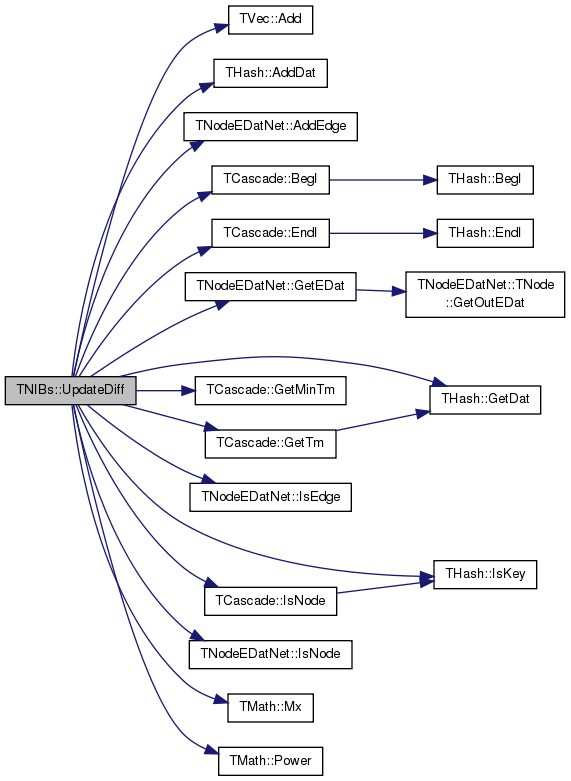
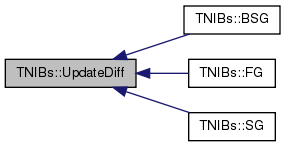
| TFltPrV TNIBs::Accuracy |
Definition at line 170 of file cascdynetinf.h.
Referenced by ComputePerformanceNId(), and Init().
| TFlt TNIBs::Aging |
Definition at line 153 of file cascdynetinf.h.
Referenced by SG().
| TIntFltH TNIBs::AveDiffAlphas |
Definition at line 162 of file cascdynetinf.h.
Referenced by BSG(), FG(), Reset(), SG(), and UpdateDiff().
| TStrIntH TNIBs::CascadeIdH |
Definition at line 135 of file cascdynetinf.h.
Definition at line 132 of file cascdynetinf.h.
Referenced by AddCasc(), BSG(), FG(), SaveCascades(), and SG().
Definition at line 138 of file cascdynetinf.h.
| TFlt TNIBs::Delta |
Definition at line 150 of file cascdynetinf.h.
Referenced by GenCascade(), and UpdateDiff().
Definition at line 163 of file cascdynetinf.h.
Referenced by Reset().
| TStrIntH TNIBs::DomainsIdH |
Definition at line 134 of file cascdynetinf.h.
Referenced by LoadGroundTruthNodesTxt(), LoadGroundTruthTxt(), LoadInferredNodesTxt(), and LoadInferredTxt().
| TFlt TNIBs::Gamma |
Definition at line 153 of file cascdynetinf.h.
| TStrFltFltHNEDNet TNIBs::InferredNetwork |
Definition at line 158 of file cascdynetinf.h.
Referenced by BSG(), ComputePerformanceNId(), FG(), GetInferredGraphAtT(), GetInferredNetworkAtT(), Init(), LabelBurstAutomaton(), LoadInferredNodesTxt(), LoadInferredTxt(), SaveInferred(), SaveInferredEdges(), SaveInferredPajek(), SG(), and UpdateDiff().
| TFlt TNIBs::InitAlpha |
Definition at line 155 of file cascdynetinf.h.
Referenced by UpdateDiff().
| TFlt TNIBs::K |
Definition at line 150 of file cascdynetinf.h.
| TFltPrV TNIBs::MAE |
Definition at line 170 of file cascdynetinf.h.
Referenced by ComputePerformanceNId(), and Init().
| TFlt TNIBs::MaxAlpha |
Definition at line 155 of file cascdynetinf.h.
Referenced by BSG(), ComputePerformanceNId(), FG(), SaveGroundTruthPajek(), SaveInferred(), SaveInferredEdges(), SaveInferredPajek(), and SG().
| TFlt TNIBs::MinAlpha |
Definition at line 155 of file cascdynetinf.h.
Referenced by ComputePerformanceNId(), GetGroundTruthGraphAtT(), GetGroundTruthNetworkAtT(), GetInferredGraphAtT(), GetInferredNetworkAtT(), LabelBurstAutomaton(), SaveGroundTruthPajek(), SaveInferred(), SaveInferredEdges(), and SaveInferredPajek().
| TModel TNIBs::Model |
Definition at line 144 of file cascdynetinf.h.
Referenced by GenCascade(), LoadCascadesTxt(), and UpdateDiff().
| TFltPrV TNIBs::MSE |
Definition at line 170 of file cascdynetinf.h.
Referenced by ComputePerformanceNId(), and Init().
| TStrFltFltHNEDNet TNIBs::Network |
Definition at line 141 of file cascdynetinf.h.
Referenced by ComputePerformanceNId(), GenCascade(), GetGroundTruthGraphAtT(), GetGroundTruthNetworkAtT(), LabelBurstAutomaton(), LoadGroundTruthNodesTxt(), LoadGroundTruthTxt(), SaveGroundTruth(), and SaveGroundTruthPajek().
Definition at line 133 of file cascdynetinf.h.
Referenced by GetGroundTruthGraphAtT(), GetGroundTruthNetworkAtT(), GetInferredGraphAtT(), GetInferredNetworkAtT(), Init(), SaveCascades(), SaveGroundTruth(), SaveGroundTruthPajek(), SaveInferred(), SaveInferredEdges(), SaveInferredPajek(), and SaveSites().
| TFltPrV TNIBs::PrecisionRecall |
Definition at line 169 of file cascdynetinf.h.
Referenced by ComputePerformanceNId(), and Init().
| TRegularizer TNIBs::Regularizer |
Definition at line 154 of file cascdynetinf.h.
| TIntIntPrH TNIBs::SampledCascadesH |
Definition at line 166 of file cascdynetinf.h.
Referenced by Reset().
| TIntFltH TNIBs::TotalCascadesAlpha |
Definition at line 159 of file cascdynetinf.h.
| TFlt TNIBs::TotalTime |
Definition at line 147 of file cascdynetinf.h.
Referenced by GenCascade().
| TFlt TNIBs::Window |
Definition at line 147 of file cascdynetinf.h.
Referenced by GenCascade(), and UpdateDiff().